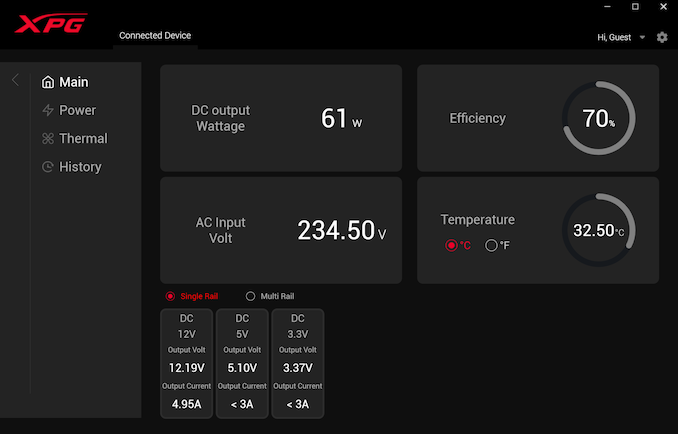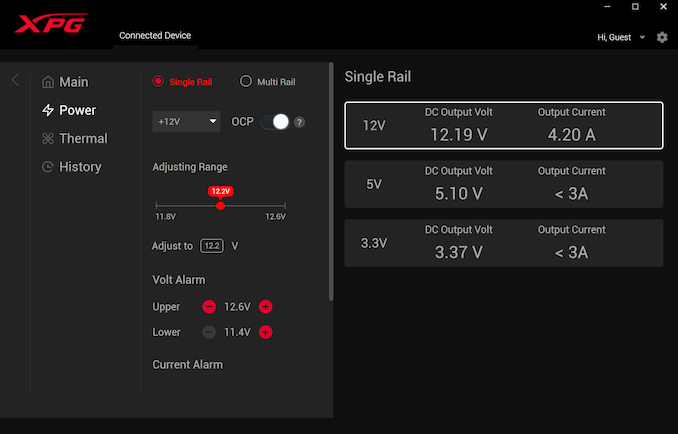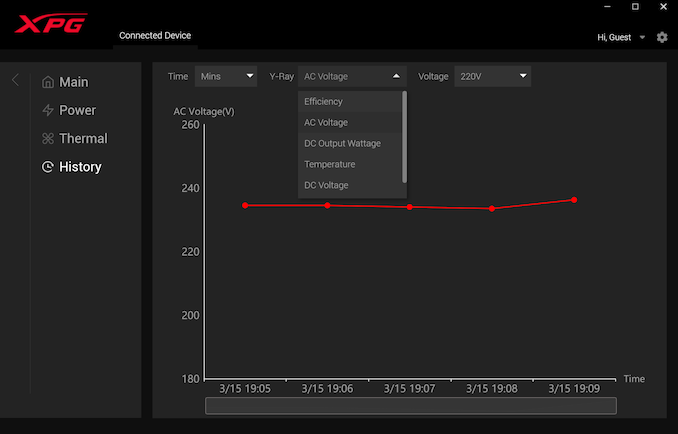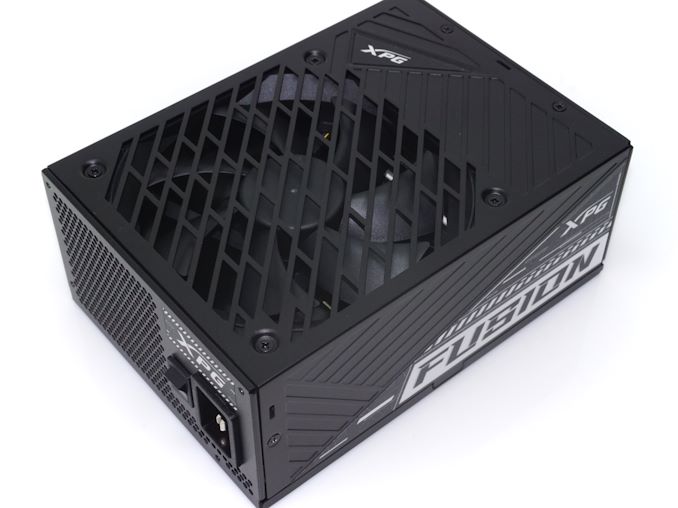The XPG Fusion Titanium 1600 PSU Review: Outrageous Power, Outstanding Quality
by E. Fylladitakis on March 30, 2023 8:00 AM ESTPower Supply Quality, Software & Conclusion
Power Supply Quality
The electrical performance of the XPG Fusion Titanium 1600 PSU is nothing short of stellar. The filtering is amazing, with the ripple hardly reaching 20 mV while the unit outputs 1600 Watts – a mere sixth of the recommended design limit, regardless of the monstrous power output. Regulation is outstanding, at 0.5% on the primary 12V line and 0.9% on the secondary 3.3V/5V lines. By default, the average output voltage for all lines is a little high but there is a reason for that, as we will see in the software section of our review.
| Main Output | ||||||||
| Load (Watts) | 326.4 W | 815.27 W | 1217.99 W | 1621.29 W | ||||
| Load (Percent) | 20.4% | 50.95% | 76.12% | 101.33% | ||||
| Amperes | Volts | Amperes | Volts | Amperes | Volts | Amperes | Volts | |
| 3.3 V | 1.9 | 3.36 | 4.75 | 3.35 | 7.13 | 3.33 | 9.51 | 3.32 |
| 5 V | 1.9 | 5.12 | 4.75 | 5.1 | 7.13 | 5.09 | 9.51 | 5.08 |
| 12 V | 25.35 | 12.24 | 63.38 | 12.23 | 95.07 | 12.18 | 126.76 | 12.16 |
| Line | Regulation (20% to 100% load) |
Voltage Ripple (mV) | |||||
| 20% Load | 50% Load | 75% Load | 100% Load | CL1 12V |
CL2 3.3V + 5V |
||
| 3.3V | 0.9% | 8 | 8 | 12 | 12 | 10 | 12 |
| 5V | 0.9% | 8 | 8 | 14 | 12 | 12 | 14 |
| 12V | 0.6% | 16 | 12 | 14 | 20 | 14 | 12 |
As part of our standard testing, we test the primary protections of all PSUs we review (Over Current, Over Voltage, Over Power, and Short Circuit). All of the protections of the XPG Fusion Titanium function normally. The OCP protection is a bit more complex, as the unit is by default programmed not to allow more than 50A per 12V virtual rail but up to 133.3A total. This is to protect single cables and connectors, as drawing 130A from a single cable would be ruinous. Trying to draw more than 52-53A from a single connector will instantly trigger an OCP shutdown. With the single-rail 12V mode, the OCP protection is a bit slack, as we reached about 120% output on the 12V rail before the OCP immediately triggered a shutdown.
Software
The XPG Fusion Titanium is one of the very few PSUs with a USB interface, allowing monitoring and customization via software. XPG integrated the Fusion Titanium within their Prime software package, which is used to control all compatible XPG devices (mainly keyboards and mice).
Once fired up, the XPG Prime will display some basic input and output electrical figures, such as the input voltage and output wattage. The input wattage does not appear but can be calculated by dividing the output wattage by the efficiency (i.e. 61 W / 0.7 = 87.1 W in this example). These readings are not terribly accurate but they are reasonably close to the actual figures.
From the Power tab, users have limited control over the output voltages and OCP protection limits. By default, the output voltages are set to 12.2V, 5.1V, and 3.4V. Users can adjust the output voltage slightly but the range is so small that will not have any practical consequence on typical PCs. OCP figures can only be adjusted downwards, i.e. users cannot set OCP limits above the maximum ratings.
The Thermal tab allows users to choose one out of three cooling profiles, or even program their own. By default, the thermal profile unit is set to “performance” mode. Switching to “silent” mode will keep the fan disabled up to a load of 600 Watts. Users can program their own cooling profiles and even disable active cooling completely if they want to - in any case, the unit’s OTP protection will ignore the cooling profile if the temperatures get out of hand.
Finally, the History tab is a record of the unit’s basic electrical and thermal figures. Users can choose the sampling rate from minutes to days. “Days” is far too slow a sampling rate for electrical figures. Even “Minutes” is not useful for anything else than indicative records, as a rate of one record per minute cannot be used for any form of accurate measurements, let alone diagnostics. For the latter, the sampling rate would need to be at least in the milliseconds range.
Conclusion
The XPG Fusion Titanium 1600 PSU undoubtedly is an exceptional product that lives up to the company’s extravagant marketing claims. It boasts excellent build quality, top-of-the-line components, and a clean design. Its OEM/ODM, Delta Electronics, is a renowned power electronics manufacturer that is known for producing top-quality products. XPG backs the unit up with a 12-year manufacturer warranty, which should be enough to dissolve any doubts regarding the quality level of the PSU.
The power supply's outstanding power quality is one of its key strengths, with great voltage filtering and very tight voltage regulation on every voltage rail. Filtering is astoundingly good for a unit with that high a power output. The electrical conversion efficiency is very high but not higher than expected for a unit that meets the 80Plus Titanium certification requirements. The unit also exhibits extreme resistance to thermal stress, operating unfazed regardless of the ambient temperature (within reasonable limits).
While noise figures depend on the selected/programmed cooling profile, the XPG Fusion Titanium can typically operate silently with loads up to 500-600 Watts. However, if pressed to operate at loads above 1200 Watts for prolonged periods, it will inevitably produce high levels of noise. Typical gaming PCs and workstations cannot maintain such a high continuous power draw but rendering stations and mining rigs will.
Overall, the XPG Fusion Titanium power supply is a halo product that is typically targeted towards hardcore enthusiasts and users who demand the very best, regardless of the price tag. And with an MSRP of $750, it definitely will be a very expensive product when it's released in May. However, for users who require extreme performance and reliability, this power supply is a solid investment that is worth every penny.
















17 Comments
View All Comments
Oxford Guy - Thursday, March 30, 2023 - link
‘These designs are not the quietest’Zero surprise that another high-rpm ball bearing fan has been used.
CindyYin - Thursday, March 30, 2023 - link
What brand of capacitors are used for the XPG Fusion Titanium 1600 PSU?ballsystemlord - Saturday, April 1, 2023 - link
Nippon Chemi-Con and Rubycon. They mentioned it in the article. Now about how people are supposedly literate in our modern age...ballsystemlord - Saturday, April 1, 2023 - link
For a unit that costs $750, I'd have thought it would run at a much lower noise level. Maybe they could use larger heatsinks next time?Oxford Guy - Saturday, April 15, 2023 - link
Ball bearing fans become louder with time, which is something reviewers never mention, too.And... if they're dropped they can be damaged. As far as I know, the more modern bearings don't have that issue.
The one thing ball bearing fans seem to do best is static pressure, though.
Eliadbu - Monday, April 3, 2023 - link
Very Large, not that quiet, very expensive.All of that for have a 1600 watt titanium PSU with ATX 3.0 and 2 12vhpwr cables. Not worth it imo but some people may look differently on this.
Also no premade cables from cablemods for their PSUs which is a down.
drajitshnew - Wednesday, April 5, 2023 - link
And all the components which enable a compact PSU but the the PSU is a giant anyway. Let's be honest this product belongs in a showcase not a computer. Along with the 15A limitation, if you really NEED the power an just get an 2KW titanium redundant unit